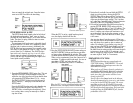
does not cancel the original note. Leave the instru-
ment set to POLY mode for the time being.
PITCH BEND RANGE & STEP
The PITCH bend wheel located at the far left side of
the keyboard can be used to "bend" notes or chords,
provided the Pitch Bend Range is set to some non-zero
value. The wheel is spring-loaded to return to center
from either direction.
The maximum pitch bend range is adjustable from 0
(no pitch bend) to a as much as 12 semitones in either
direction (plus or minus an octave). Additionally the
PITCH wheel can be programmed for a smooth, contin-
uous bend, or the change can occur in "steps" of a size
you set (from 0 to 12 semitones). The RANGE adjust-
ment works only when the step size is set to 0; when
discrete steps are selected, the maximum range is 1
octave, with the step size determining the highest and
lowest pitch actually available.
1. Press the [PITCH BEND-STEP] button first. This sets
the [DATA ENTRY] slider and buttons so they can
adjust the size of the steps that will be produced when
you operate the PITCH bend wheel. Try it — move
the [DATA ENTRY] slider (or press the adjacent [<]
and [>] buttons) — then play a note and move the
PITCH wheel.
Since the RANGE function works only when the step
size is zero (continuous glide), move the [DATA
ENTRY] slider, or instead press the adjacent [-1] but-
ton as many times as may be necessary to obtain a
step size of zero.
2. Press the [PITCH BEND-RANGE] button and move
the [DATA ENTRY] slider up and down to get differ-
ent range values displayed in the window. Play a note
or chord and use the PITCH wheel to try each setting.
When you've experimented, leave the system set for a
maximum 12 semitone pitch bend range. (As soon as
you select a [STEP] size other than zero, the
[RANGE] is automatically reset to 12 semitones.)
Then use either of these
When the DX7 is set for a pitch bend step size of
zero, the display should look like this:
Then use either of these
When the DX7 is set for a pitch bend range of plus or
minus an octave, the display should look like this:
3. Notice that if you hold a key and hold the PITCH
wheel at a given position, moving the [DATA
ENTRY] slider will not have an effect. You have to
release the wheel first and then play to hear the effect
of the new pitch bend range setting. (This "set-then-
test" rather than "set-while-testing" function character-
izes many of the DX7 programming controls.)
4. Go back and experiment with different step sizes by
pressing [PITCH BEND-STEP] and moving the
slider and/or pressing the [+1] and [-1] buttons. The
bend was continuous with the step size at 0. A step
size of 1 enables you to hear each semitone as you
move the wheel, and, at the other extreme, a step
size of 12 means you'll hear the note or chord "jump"
a full octave.
Any step size above 0 sets the range to 12, but spe-
cific step sizes affects the maximum available range; it
may not always be as much as plus or minus an
octave. For example, if you choose a step size of 5
steps, and move the PITCH wheel slightly you'll get a
jump up or down of 5 semitones. Full deflection of
the wheel from its resting position will cause the pitch
to jump up or down a total of 10 semitones... and
that's it. A range of 6 steps, however, would allow for
an octave of pitch "bend" in 2 increments.
PORTAMENTO FUNCTIONS
NOTES
Several related functions are qrouped under the
FUNCTION heading "PORTAMENTO." The actual
effects obtained will depend upon more than the
PORTAMENTO settings.
What you hear will change when the synthesizer is
set to POLY or MONO mode. We initially explore the
PORTAMENTO and GLISSANDO effects in POLY
mode since that is the mode to which we have.
already set the DX7.
Specific effects also change based on the inherent
sustain programmed into a given voice, and whether
or not you use the SUSTAIN foot pedal. We recom-
mend that you have the FC-4 or FC-5 foot switch
plugged into the rear panel SUSTAIN jack in order to
fully benefit from these instructions. If a footswitch is
not plugged into the PORTAMENTO jack, then the
portamento will be ON.
17


















